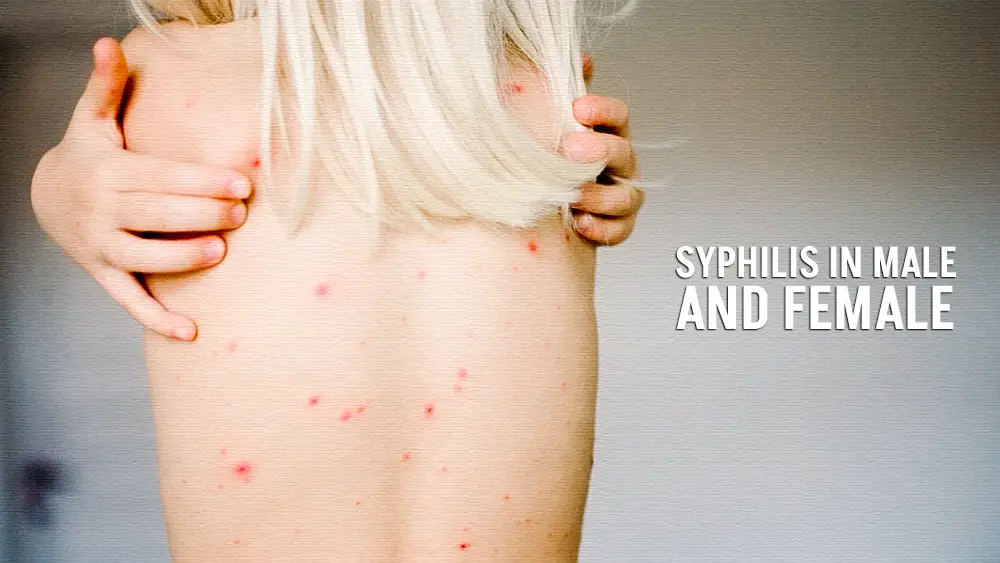
HEALTH BLOG
What does syphilis look like on a man and a woman? The best way to find out quickly
-
Rahul Priydarss
O
ne of the challenges in combating syphilis lies in early detection, as its symptoms of What does syphilis look like on a man and a woman? can often be subtle or mistaken for other ailments. Their findings indicate that there are effective treatments for syphilis.

Table of Contents
What is Syphilis:
Syphilis, a sexually transmitted infection (STI) caused by the bacterium Treponema pallidum, has been a persistent concern in public health. While its prevalence has fluctuated over the years, recent data suggests a troubling resurgence, particularly in certain demographics. One of the challenges in combating syphilis lies in early detection, as its symptoms can often be subtle or mistaken for other ailments. In this article, we’ll delve into what syphilis looks like in both men and women and explore the best ways to identify it quickly.
Stages of Syphilis:
The Syphilis stages are three types.
- Primary
- Secondary
- Tertiary Stages
1- Primary: The primary stage of syphilis typically begins with the appearance of a small, painless sore called a chancre. This sore may develop on the genitals, anus, or mouth, depending on the mode of transmission. In men, chancres often appear on the penis, while in women, they may occur on the vulva, vagina, or cervix. Chancres can also be found on the lips, tongue, or inside the mouth after oral sex with an infected partner.
2- Secondary: If left untreated, syphilis progresses to the secondary stage, which usually occurs several weeks to months after the appearance of the chancre. In this stage, many people may experience a range of symptoms, including:
- Skin rashes, often appearing as reddish-brown sores that are not itchy
- Fever
- Fatigue
- Sore throat
- Swollen lymph nodes
- Headaches
- Muscle aches
In both men and women, these symptoms can be mistaken for other common illnesses, leading to delayed diagnosis and treatment. However, the presence of skin rashes, especially on the palms of the hands and the soles of the feet, is characteristic of secondary syphilis and can help differentiate it from other conditions.
3- Tertiary Stages: Without treatment, syphilis progresses to the latent stage, during which the infection remains dormant and may not cause any noticeable symptoms. However, if left untreated for years, syphilis can advance to the tertiary stage, which can lead to severe complications such as cardiovascular problems, neurosyphilis (affecting the nervous system), and gummatous syphilis (resulting in soft tissue destruction).
Understanding Syphilis Symptoms:
Syphilis presents itself in distinct stages, each with its own set of symptoms. These stages include primary, secondary, latent, and tertiary. Here’s a breakdown of each stage in Detail:
- Primary Syphilis Symptoms: This stage typically begins with the appearance of a small, painless sore called a chancre. These chancres can appear on the genitals, anus, or mouth and may go unnoticed due to their painlessness. However, they are highly contagious.
- Secondary Syphilis Symptom: If left untreated, syphilis progresses to the secondary stage, marked by a rash that can appear on the palms of the hands, soles of the feet, or other parts of the body. and many other symptoms include fever, sore throat, swollen lymph nodes, and fatigue. The rash may be mistaken for other conditions like eczema or allergic reactions.
- Latent Syphilis Symptom: In this stage, the infection remains dormant, with no visible symptoms. However, the bacteria are still present in the body and can lead to complications if left untreated.
- Tertiary Syphilis Symptom: Without proper treatment, syphilis can advance to its most severe stage, which can affect various organs such as the brain, heart, and nervous system. Tertiary syphilis can result in serious health problems, including neurological disorders and cardiovascular complications.einIn
Syphilis Symptoms in Men and What does syphilis look like on a Man:
In men, syphilis symptoms often manifest as follows:
- Primary Stage: The development of chancres, typically on the penis, scrotum, or around the anus. These sores are painless and may go unnoticed.
- Secondary Stage: Following the resolution of chancres, a rash may appear on the trunk, extremities, or genitals. Other symptoms like fever, sore throat, and swollen lymph nodes may also occur.
- Tertiary Stage: Without treatment, syphilis can progress to affect organs and systems, leading to serious health issues.
Female Sexual Disease and What does syphilis look like on a Woman:
- Primary Stage: Women infected with syphilis may develop painless chancres (sores) on the vulva, vagina, cervix, or around the anus. These chancres can also occur in the mouth if the infection is transmitted through oral sex. It’s important to note that these chancres are highly contagious and may go unnoticed due to their painlessness. According to CDC statistics, approximately 30% of women with syphilis report having cancer.
- Secondary Stage: Following the resolution of chancres, a rash may appear on the trunk, extremities, palms of the hands, soles of the feet, or genitals. This rash is characteristic of secondary syphilis and can vary in appearance, often presenting as reddish-brown spots. Along with the rash, women may experience symptoms such as fever, sore throat, swollen lymph nodes, and fatigue. The prevalence of secondary syphilis among women varies but is estimated to be around 10% of reported cases.
- Tertiary Stage: While less common due to advancements in medical care and the availability of treatment, untreated syphilis can progress to its tertiary stage in some cases. Tertiary syphilis can affect various organs and systems, leading to serious health complications such as neurosyphilis, cardiovascular syphilis, and gummatous syphilis. The prevalence of tertiary syphilis among women is relatively low compared to primary and secondary stages, thanks to early diagnosis and treatment efforts.

Prevalence of Sexual Diseases in Women:
To provide further context, let’s consider the prevalence of sexual diseases, including syphilis, among women in the United States. According to recent CDC data.
- Syphilis: In 2020, there were approximately 140,000 reported cases of syphilis in the United States, with women accounting for about 32% of these cases. This represents a concerning trend, as the number of reported cases has been steadily increasing in recent years, particularly among women of reproductive age.
- Chlamydia: Chlamydia is the most commonly reported bacterial STI in the United States, with over 1.5 million cases reported in 2020. Women are disproportionately affected by chlamydia, accounting for approximately 60% of reported cases. Chlamydia can lead to serious complications such as pelvic inflammatory disease (PID) and infertility if left untreated.
- Gonorrhea: Gonorrhea is another common STI, with over 400,000 cases reported in the United States in 2020. Similar to chlamydia, women represent a significant portion of reported gonorrhea cases, accounting for approximately 52% of infections. Untreated gonorrhea can also lead to PID and other reproductive health issues.
Diagnosis and Effective Treatment:
Given the varied and sometimes elusive nature of syphilis symptoms, prompt diagnosis is crucial. Here are some steps individuals can take to ensure timely detection.
- Regular STI Testing: Routine screening for syphilis and other STIs is essential, especially for sexually active individuals and those with multiple partners.
- Consultation with Healthcare Providers: If you notice any unusual symptoms or have concerns about potential exposure to syphilis, seek medical advice promptly. Healthcare providers can conduct appropriate tests and guide treatment options.
- Awareness and Education: Educate yourself and others about the signs and symptoms of syphilis. Increased awareness can lead to early recognition and treatment, reducing the risk of complications and transmission.
- Safe Sexual Practices: Practicing safe sex, including consistent condom use and limiting sexual partners, can help prevent the spread of syphilis and other STIs.
- Partner Notification: If diagnosed with syphilis, inform your sexual partners so they can seek testing and treatment as well. This can help prevent further transmission within the community.
Prevention:
The best way to prevent syphilis and other STIs is to practice safe sex. This includes using condoms correctly and consistently, limiting the number of sexual partners, and avoiding high-risk sexual behaviors. Regular STI testing, especially for individuals with multiple sexual partners or a history of STIs, is also essential for early detection and treatment.
Frequently Asked Questions (FAQs):
A1: Primary symptoms include painless chancres on the genitals, anus, or mouth, appearing about three weeks after exposure to the bacterium.
A2: Secondary symptoms may include skin rashes, fever, fatigue, sore throat, and swollen lymph nodes. Skin rashes, particularly on the palms and soles, are characteristic, though symptoms can vary between men and women.
A3: Diagnosis involves a combination of medical history, physical examination, and laboratory tests. Treatment typically includes antibiotics, especially penicillin, which are effective in curing syphilis.
A4: Practicing safe sex by using condoms consistently and correctly, limiting sexual partners, and undergoing regular STI testing are key prevention strategies. Early detection and treatment are crucial for managing syphilis and preventing its complications.
A4: Regular dental check-ups are essential for professional cleanings and early detection of potential issues. Dentists can provide personalized advice and treatments to maintain optimal oral health.

-Remember, Always consult with healthcare professionals or Doctors for personalised advice related to medical conditions.
Conclusion:
Syphilis remains a significant public health concern, with its resurgence highlighting the importance of early detection and treatment. What does syphilis look like on a man and a woman? Recognizing the symptoms of syphilis in both men and women is essential for swift diagnosis and intervention. By prioritizing regular STI testing, seeking medical advice when needed, and promoting awareness within our communities, we can work towards reducing the burden of syphilis and safeguarding public health. Remember, knowledge and proactive measures are our best defense against this persistent infection.




